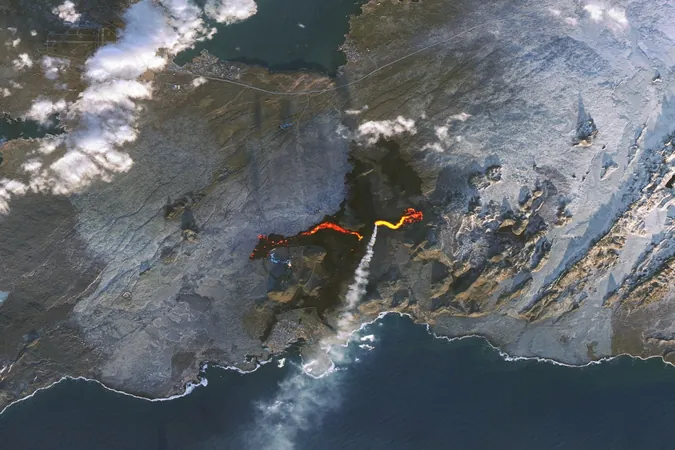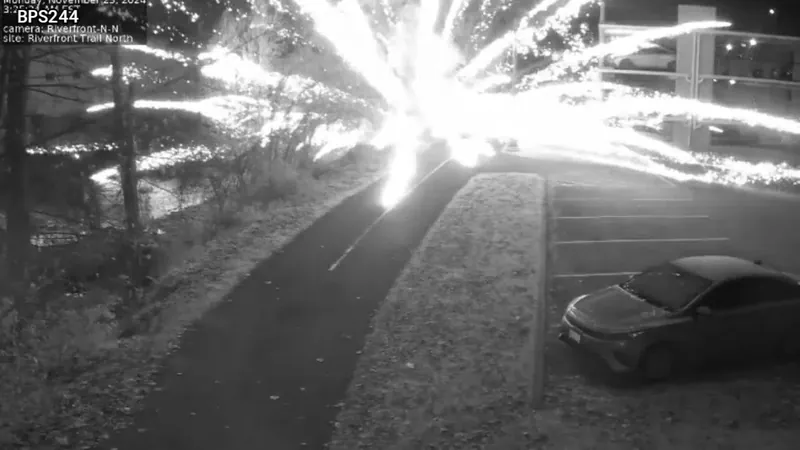
Lava Flow Alarm: Iceland's Famous Blue Lagoon on High Alert!
2024-11-27
Author: Noah
Imagine luxuriating in Iceland’s famed Blue Lagoon, enveloped in the warm, rejuvenating waters, with a mud mask enhancing your relaxation. Now, picture this serene escape abruptly interrupted by an urgent order to evacuate! What could possibly escalate a spa day to a safety emergency? A creeping lava flow is making its perilous approach toward this beloved hotspot.
Volcanic Activity Detected
On November 20, the Icelandic Meteorological Office detected a series of tremors on the Reykjanes Peninsula, indicating the eruption of a volcanic fissure near Stóra Skógfell hill, located roughly 31 miles (50 kilometers) southwest of Reykjavik, the nation’s capital. This fissure, where lava emanates from a crack in the earth, has already set off a luminous flow, diverting in both eastern and western directions. Remarkably, while it spared the nearby town of Grindavík, it engulfed main roads, along with the parking area and smaller service structures of the Blue Lagoon resort.
Evacuations and Air Travel
While parts of Grindavík were evacuated as a precaution, the report from the Icelandic National Broadcasting Service confirmed that the Blue Lagoon spa and resort followed suit. Despite hazardous fumes, primarily sulfur dioxide, billowing from the molten rock, air travel remained unaffected—much to the delight of some passengers who were fortunate enough to witness this fiery wonder from above, as it lies close to Keflavík Airport.
A New Volcanic Era
This eruption marks the seventh incident in a dramatic series that ignited last December and the tenth in an ongoing geological phenomenon that began in March 2021. Before this resurgence, the Reykjanes volcanic system had lulled in dormancy for nearly 800 years, ushering in what could be considered a new volcanic era for the peninsula.
Impact on Tourism
Observing the ground shift, Thorgils Jónsson, a reporter for the broadcasting service, noted the fissure’s menacing northward expansion. “As I stand here, I can clearly observe the fissure inching upward,” he stated on the day of the eruption, highlighting the significant threat posed to the surrounding areas.
Iceland is undeniably a land of fire and ice, renowned for its volcanic activity. The nation, shaped by the magma emerging from the mid-ocean ridge, experiences an average of one volcanic eruption every five years. However, the recent patterns show a stark increase since 2021, now averaging nearly once a year.
Pulling on the imaginative allure of Iceland’s landscapes, this volcanic activity hasn't deterred tourists. Instead, the nation has cemented itself as a top travel destination, especially demonstrating a robust rebound from the constraints imposed by the COVID-19 pandemic. Interestingly, even one of the most catastrophic eruptions in recent history—Eyjafjallajökull in 2010—was leveraged by Iceland's government to catalyze a vigorous tourism campaign.
Conclusion
As Iceland continues to entertain visitors with its breathtaking scenery and geothermal wonders, the latest disturbance serves as a reminder of nature’s unpredictability and the delicate balance of enjoying such majestic landscapes. Is your next vacation to the Blue Lagoon just around the corner, or could a fiery spectacle add a thrilling twist to your travel plans? Booking soon might just be the perfect decision!









 Brasil (PT)
Brasil (PT)
 Canada (EN)
Canada (EN)
 Chile (ES)
Chile (ES)
 España (ES)
España (ES)
 France (FR)
France (FR)
 Hong Kong (EN)
Hong Kong (EN)
 Italia (IT)
Italia (IT)
 日本 (JA)
日本 (JA)
 Magyarország (HU)
Magyarország (HU)
 Norge (NO)
Norge (NO)
 Polska (PL)
Polska (PL)
 Schweiz (DE)
Schweiz (DE)
 Singapore (EN)
Singapore (EN)
 Sverige (SV)
Sverige (SV)
 Suomi (FI)
Suomi (FI)
 Türkiye (TR)
Türkiye (TR)